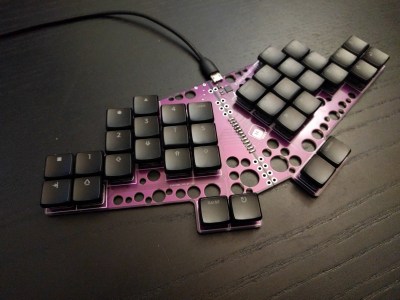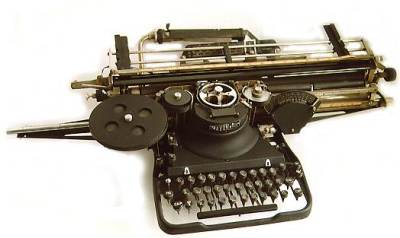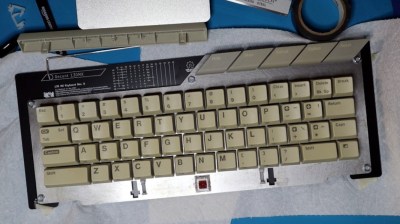
According to Google Translate, kleks is Polish for (and I’m cherry-picking definitions here) the word ‘splash’. Well, [deʃhipu]’s hole-ful and soulful Kleks Keyboard certainly made a splash with me. [deʃhipu] knows what I’m talking about. As I said in Discord, I just love the look of those holes. They’re purely aesthetic and do a nice job of showing off [deʃhipu]’s routing skills.
One might argue that those holes also functional in that they increase aerodynamics and remove a not-insignificant amount of weight for travel considerations. But yeah, they mostly are there to look cool. Upon closer inspection, I saw that the two halves are joined with a series of soldered stitches that are made from a [ggconnector] bent into a u-shape. Now it’s a toss-up as to which is my favorite feature.
It seems that [deʃhipu] is never completely satisfied by this or that keyboard build, and that’s okay. That’s normal. That is . . . a big part of what this hobby is all about. Because honestly, what would be the fun in finding The One? We wonder what will happen when the droplets settle. Will [deʃhipu] be satisfied with the Kleks, or will those stylish holes become un-fillable voids?
The Kinesis Advantage360 is Finally Almost Here
After months of teaser tweets featuring frustratingly-framed macro shots of a render, a real update with full-body shots is finally here. The Kinesis Advantage360 will be available for pre-order as of December 20th. Sad to say, I was not chosen for their beta testing program, and I doubt there’s money in the budget for me to upgrade from my 20-year-old original Advantage, so I’ll just have to pore over the page and pretend.

So it’s gonna come in two flavors — the 360 and the 360 Professional. The 360 is USB-C and uses Kinesis’ SmartSet on-board programming, whereas the Professional is Bluetooth, runs on ZMK, and has white-only blinkenlights. Aside from these upgrades, the biggest change is obviously the move to a two-piece split. Are you used to a monoblock split and need training wheels? There’s a bridge piece included that puts the halves at standard Advantage distance apart. It would be nice if the bridge was adjustable so that you could play with the distance and/or move the keyboard around on the desk and not worry about lining the halves up again. One thing you can adjust is the tenting, which has three different heights.
This one is almost a dealbreaker for me — there are no dedicated Function keys anymore because they’re on a layer like the ten-key has always been. On the upside, there are two new pinky keys, which honestly is probably enough F keys for me. There are also four new hot keys labeled 1-4 if you want more F keys on the base layer.
For now, it looks like both models only come with browns. Kinesis have switched from Cherry to Gateron after all this time, and I’m not sure I’m down with that, especially considering how much they are asking for these keyboards. However, Kinesis partnered with Upgrade Keyboards who will customize the switches if you buy one from them beginning in late 2022. I’ve always wanted a Kinesis with blues, but I think I’ll stick to hacking on an old Advantage.
Historical Clackers: the Varityper

[Nick Bodley] wrote to me personally (thanks, Nick!) to tip me off to the Varityper typesetter. This bad boy sprouted from the Hammond typewriter mechanism and was known for its interchangeable typefaces, which made it a great early tool for graphic design. This website has a lot of information and examples of what it could do.
[Nick] thinks they were all a bit ugly (the machines, not the typefaces), but that is probably because of all the improvements over the years that seem to have been slapped on top of the original design. The Varityper pictured here is from 1937, after the company changed hands and the machine had undergone some 3,000 modifications (so the story goes).
One big problem with the Varityper was the geometry of the font elements, which were were shaped like half-circles. After a few years, these would become unevenly worn from use, and all the characters on the edges would lose their crispness and become almost useless. In later years, the Varityper made a major change from an electro-mechanical machine to a computerized phototypesetter that flashed the characters’ images onto photographic paper.
ICMYI: Atari 130XE Keyboard Goes Mechanical
 Sometimes it’s a tough call. Should [Bertrand] have restored that beloved childhood peripheral to its original, albeit unsatisfying mushy membrane glory (if you even can call it that)? We say no way. [Bertrand] absolutely did the right thing by upgrading the keyboard of his Atari 130XE to mechanical switches while keeping the stock keycaps.
Sometimes it’s a tough call. Should [Bertrand] have restored that beloved childhood peripheral to its original, albeit unsatisfying mushy membrane glory (if you even can call it that)? We say no way. [Bertrand] absolutely did the right thing by upgrading the keyboard of his Atari 130XE to mechanical switches while keeping the stock keycaps.
[Bertrand] pulled off this hack by 3D printing new stems for every Kailh box pink that replaced a pair of membrane contacts. The business end can be used with either variant of Atari keycaps from that era. Of course, this also required a new PCB and an adapter board, but those were no trouble for [Bertrand]. Be sure to check this project out, because it was fully intended to be reproduced.
Got a hot tip that has like, anything to do with keyboards? Help me out by sending in a link or two. Don’t want all the Hackaday scribes to see it? Feel free to email me directly.















Maybe the holes in the PCB are useful for storing change for the vending machine?
Keychain (Kebchain?)
I was thinking they could be worn like brass knuckles.
They can also be used to measure spaghetti portions
[Comment for the editor: kleks means an unwanted splash of ink, an inkblot, usually from a fountain pen. The latter is only a hypothesis, but “kleks” might have been chosen for similarity of sound to “clacks”.]
I choose “kleks” because due to being symmetric the keyboard looks a bit like those splotches of ink used in psychology tests, and “Rorschach” was already taken. Then I remembered a character from Szarlota Pavel comic books.
Has anybody seen a keyboard with different pressures per key? For example, the Enter key could offer more resistance. That would be a nice form of haptic feedback.
That does sound nice. Mechanical keyboards often have a heavier switch in the space bar. I have long thought about building a keyboard with lighter-force switches on the pinky keys.
It’s actually quite popular, though there is no agreement on which keys should have stronger springs and which should have lighter. You can even buy ready sets of replacement springs, and do it yourself.
(+1) will try that out!
Yes, I’ve done this, and I think I’ve heard of other people doing it too. One of my work keyboards is a Cherry MY-series board which (while not mechanical) has spring-loaded mechanical slides over a membrane. A few years ago I pulled out the springs on the letter keys, which made the letters easier to press than red switches and leaving the surrounding keys with a heavier actuation force.
It did help let me know when my fingers started wandering off the letters, but it was more useful to switch out my Caps Lock key with a shorter one that doesn’t touch the A key.
nice but too small
Good Lord, I can’t stop laughing. That hyphen totally split that title into two distinct sentences for a confused moment there. I was so curious about a ‘y keyboard’, and whoever would actually print the first sentence.
I’m so sorry Kristina, it’s such a good article though!